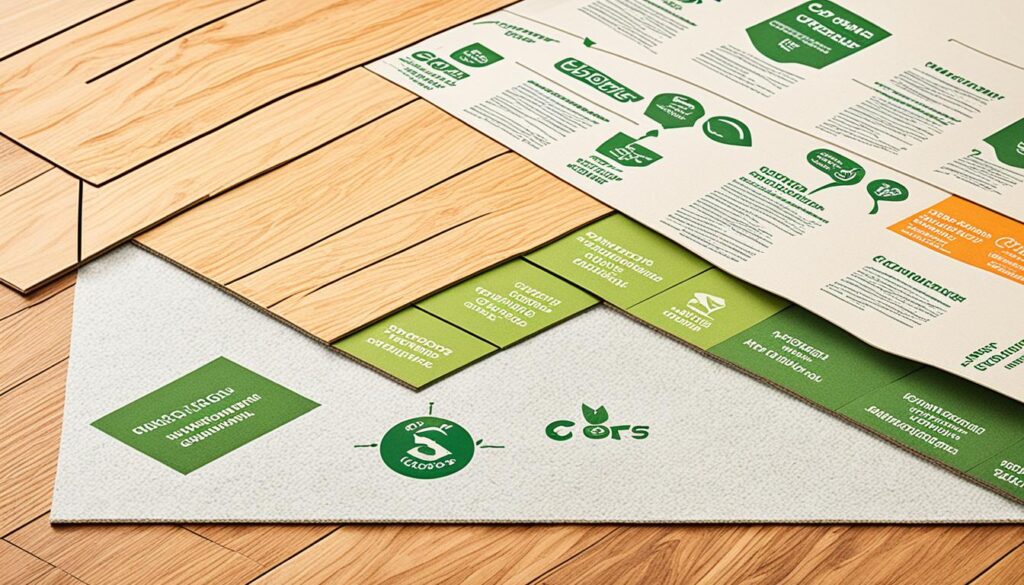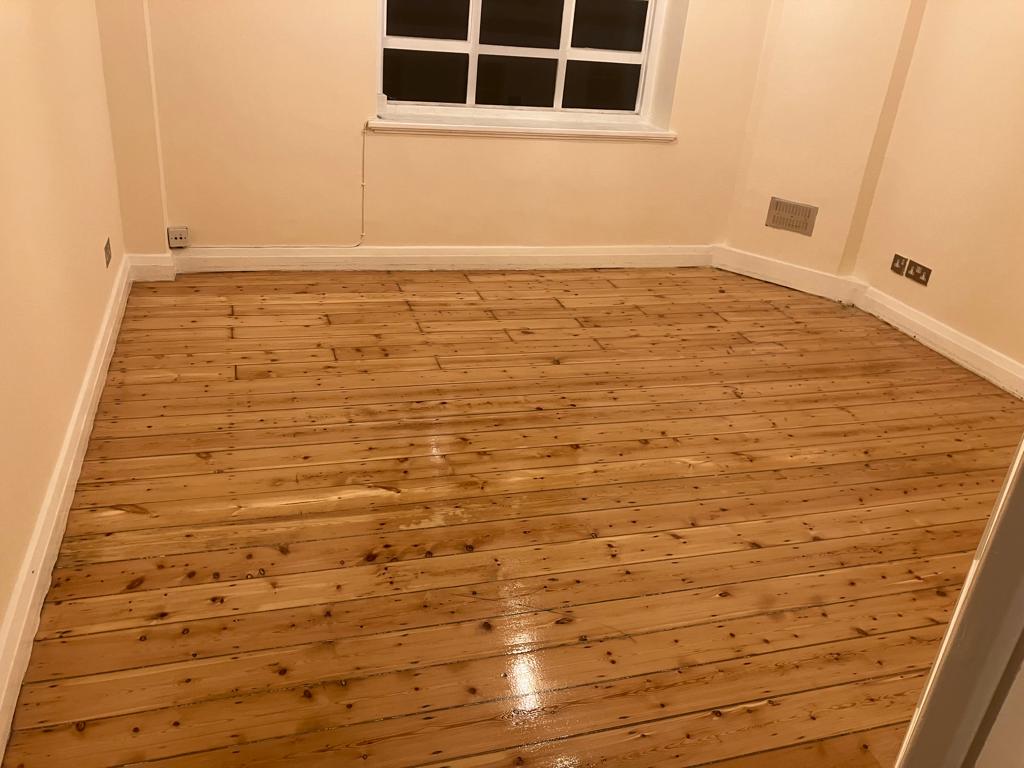When renovating your wood floors, it is important to consider sustainable underlayment options. Underlayment serves as a layer of material between the subfloor and the floor, providing stability, sound absorption, and moisture protection. There are four main types of underlayment to choose from: felt, foam, cork, and rubber. Each has its own qualities and capabilities, so it is important to research and select the right option for your specific needs.
Felt underlayment provides basic moisture resistance and sound absorption, while foam offers affordability and easy installation. Cork underlayment is environmentally friendly and has excellent sound absorption properties, while rubber provides flexibility, moisture resistance, and superior sound absorption. Consider the type of wood flooring and the specific needs of the room when choosing the right underlayment for your wood floor renovation project.
Key Takeaways:
- Underlayment is a layer of material between the subfloor and the floor that provides stability, sound absorption, and moisture protection for wood floors.
- There are four main types of underlayment options for wood floor renovation: felt, foam, cork, and rubber.
- Felt underlayment offers basic moisture resistance and sound absorption, while foam is affordable and easy to install.
- Cork underlayment is environmentally friendly and has excellent sound absorption properties, while rubber provides flexibility, moisture resistance, and superior sound absorption.
- Consider the type of wood flooring and the specific needs of the room when choosing the right underlayment for your wood floor renovation project.
What is Underlayment and Why You Need It
Underlayment is a layer of material between the subfloor and the floor that provides support, stability, and durability to wood floors. While underlayment is not always necessary, it offers several benefits. It improves the stability and durability of the flooring, helps smooth subfloor imperfections, provides sound absorption, and protects the wood floors from moisture damage. Underlayment is particularly important for wood floorings as it helps prevent warping and other expensive damages caused by moisture. By choosing the right underlayment, you can enhance the lifespan and performance of your wood floors.
Installing underlayment beneath your wood floors is crucial for maintaining their integrity and longevity. Without proper underlayment, wood flooring may become unstable, leading to significant damage over time. Underlayment provides support and stability to prevent the floors from shifting or creaking, ensuring a solid foundation for your wood flooring investment.
In addition to stability and durability, underlayment also offers sound absorption properties. It helps to minimize noise from foot traffic and other activities, creating a quieter and more comfortable living environment. By reducing sound transmission, underlayment can greatly enhance the acoustic properties of your wood floors.
Moisture damage is a common concern for wood floors, especially in areas prone to high humidity or moisture exposure. Underlayment acts as a barrier, protecting the wood from moisture infiltration. It helps to prevent warping, cupping, and other issues caused by excessive moisture absorption, ensuring that your wood floors remain in excellent condition for years to come.
Quote: “Underlayment plays a crucial role in ensuring the stability, durability, and protection of wood floors. It provides a solid foundation, absorbs sound, and safeguards against moisture damage.” – Wood Flooring Experts
When choosing underlayment for your wood floors, consider the specific needs of your project. Factors such as the type of wood flooring, the installation method, and the room’s usage should all be taken into account. Different underlayment materials offer unique characteristics and performance qualities. For example:
- Felt underlayment provides basic moisture resistance and sound absorption properties.
- Foam underlayment is affordable and easy to install, offering cushioning and flexibility.
- Cork underlayment is an environmentally friendly option with excellent sound absorption and stability.
- Rubber underlayment offers superior moisture resistance and sound absorption, providing extra protection for your wood floors.
Consulting a professional wood floor contractor will help you determine the most suitable underlayment option for your specific needs and wood flooring type. They can assess the conditions, recommend the best underlayment material, and ensure proper installation for optimal performance and longevity.
Choosing the Right Underlayment: A Comparison
| Underlayment Material | Key Features |
|---|---|
| Felt | Basic moisture resistance Sound absorption |
| Foam | Affordable and easy to install Cushioning and flexibility |
| Cork | Environmentally friendly Excellent sound absorption and stability |
| Rubber | Superior moisture resistance Sound absorption and extra protection |
Table: A comparison of different underlayment materials for wood floors.
Hardwood Floor Underlayment Options
When it comes to choosing the right underlayment for your hardwood floors, there are four main options to consider: felt, foam, cork, and rubber. Each of these underlayment types offers unique characteristics and benefits that cater to different needs and preferences. Let’s take a closer look at each option:
Felt Underlayment
Felt underlayment is a popular choice for hardwood floors due to its basic moisture resistance and sound absorption properties. This type of underlayment is commonly made from recycled materials, making it an environmentally friendly option. It provides a solid foundation for your hardwood flooring while ensuring a quieter and more comfortable living space.
Foam Underlayment
For those on a budget or looking for easy installation, foam underlayment is a great option. It offers affordability without compromising on quality. Foam underlayment provides extra cushioning, flexibility, and sound absorption, enhancing the overall comfort and performance of your hardwood floors.
Cork Underlayment
If you’re looking for an underlayment option that is both environmentally friendly and offers excellent sound absorption, cork underlayment is a top choice. Cork is a renewable resource, making it a sustainable option for your hardwood floors. Additionally, cork underlayment adjusts to imperfections in the subfloor, providing extra stability and ensuring a smooth and even installation.
Rubber Underlayment
For superior moisture resistance and sound absorption, rubber underlayment is the way to go. This type of underlayment offers flexibility and durability, ensuring long-lasting protection for your hardwood floors. Rubber underlayment also provides a comfortable walking surface and helps prevent moisture-related issues, making it an excellent choice for areas prone to humidity or moisture concerns.
When selecting the right underlayment option for your hardwood floor renovation project, it is essential to consider your specific needs. Factors such as moisture resistance, sound absorption, and environmental sustainability should all be taken into account. By choosing the appropriate underlayment, you can enhance the performance, durability, and overall beauty of your hardwood floors.

How to Choose the Right Underlayment
When it comes to choosing the right underlayment for your wood floor renovation, there are a few key factors to consider. One important consideration is the type of wood species you will be using. Different wood species have different characteristics, and choosing the appropriate underlayment can help enhance the stability and durability of your floors.
If you are working with softer wood species, such as pine or cedar, it is recommended to opt for underlayments that provide additional support and stability. Cork or rubber underlayment can offer the necessary cushioning and reinforcement for these types of wood. On the other hand, if you are working with harder wood species like oak or walnut, you may want to consider underlayments that offer insulation and flexibility, such as foam or rubber.
Another important consideration is the specific needs of the room where the flooring will be installed. If the room experiences high levels of activity or foot traffic, it is crucial to select an underlayment that provides extra stability and durability. Additionally, if the flooring will be installed in a second-floor room or above, sound absorption becomes a crucial factor to consider.
Take the time to assess your room’s needs and the characteristics of your chosen wood species before making a decision on the underlayment. By choosing the right underlayment, you can ensure that your wood floor renovation project has the necessary stability, durability, and sound absorption for long-term success.

Summary:
Choosing the right underlayment is essential for a successful wood floor renovation project. By considering factors such as the wood species and the specific needs of the room, you can select an underlayment that provides the necessary stability, durability, and sound absorption. Whether you are working with a softer or harder wood species, there are underlayments available to meet your requirements. Take the time to assess your needs and make an informed decision for a long-lasting wood floor renovation.
Conclusion
When it comes to wood floor renovation, choosing the right underlayment is crucial. Not only does it provide stability and durability, but it also offers sound absorption and moisture protection. To ensure a sustainable and long-lasting renovation, consider underlayment options such as felt, foam, cork, or rubber.
By selecting sustainable underlayment materials, you contribute to the preservation of the environment while enjoying a beautiful and functional wood floor. Felt underlayment provides basic moisture resistance and sound absorption. Foam underlayment is affordable and easy to install. Cork underlayment is an eco-friendly choice with excellent sound absorption properties. Rubber underlayment offers flexibility, moisture resistance, and superior sound absorption.
When deciding on the right underlayment for your wood floor renovation, take into account the specific needs of your floors and the room in which they are located. Consider factors such as wood species, level of activity, and traffic. Additionally, sound absorption becomes particularly important for upper-level rooms. With proper underlayment, your wood floor renovation will not only stand the test of time but also be a sustainable investment in the durability and beauty of your home.





